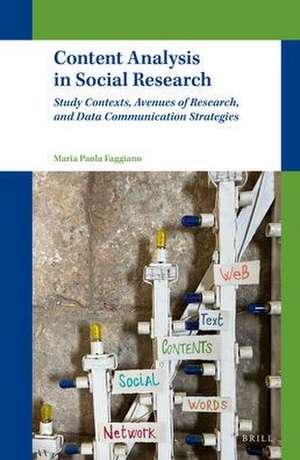Content Analysis in Social Research: Study Contexts, Avenues of Research, and Data Communication Strategies
Autor Maria Paola Faggianoen Limba Engleză Hardback – 7 dec 2022
Preț: 560.99 lei
Preț vechi: 684.14 lei
-18% Nou
Puncte Express: 841
Preț estimativ în valută:
107.38€ • 116.68$ • 90.26£
107.38€ • 116.68$ • 90.26£
Carte indisponibilă temporar
Doresc să fiu notificat când acest titlu va fi disponibil:
Se trimite...
Preluare comenzi: 021 569.72.76
Specificații
ISBN-13: 9789004537828
ISBN-10: 9004537821
Dimensiuni: 155 x 235 mm
Greutate: 0 kg
Editura: Brill
Colecția Brill
ISBN-10: 9004537821
Dimensiuni: 155 x 235 mm
Greutate: 0 kg
Editura: Brill
Colecția Brill
Notă biografică
Maria Paola Faggiano, Ph.D. in Methodology of Social Sciences, Tenure-track assistant professor of Sociology, Sapienza-University of Rome. She has published monographs and many articles on methodological issues. Among her recent publications, Content Analysis and Digital Data: Methodological Solutions between Tradition and Innovation. The Case of Digital Campaigns as Meeting Ground of Expertises and Research Perspectives (with Gallo R., Italian Sociological Review, 2021).
Cuprins
List of Illustrations
Introduction: Interrogating Textual Material in Today’s Day and AgeCharacteristics and Contexts of Use of Content Analysis
1 Content Analysis in Social Research: A Methodological Point of View
1Guidelines for the Qualitative Analysis of Content
1.1Detecting and Analyzing a Text Qualitatively
1.2An Example: The Testimony of a Sample of Neet Youngsters
2Statistical-Textual Analysis: Foundations and Perspectives of Analysis
2.1 Preliminary Checks
2.2 Types of Obtainable Outputs
2.3 Pros and Cons of Statistical-Textual Analysis
3Distinctive Features of Content Analysis as a Survey
3.1 Identification of the Unit of Analysis and Temporal Placement of the Investigation
3.2 From Designing an Analysis Sheet to Collecting Information
3.3 Analysis and Presentation of Findings
2 The Analysis of Digital Campaigns The Case Study of the Italian General Elections
1Introduction
2Twitter, TV and Political Participation in the Electoral Campaign: Zooming in on the 2013 Parliamentary Elections in Italy
3Themes, Actors and Contexts in the Italian Digital Campaign 2018
3.1Focalizing on Themes
3.2Political Actors: Allies and Opponents
3.3The Use of Numbers to Denounce and Inform: Sources and Statistics in the Digital Campaign
3.4Social Actors: Who to Include, Who to Exclude
3.4References to Territory Contained in Posts
3 Local Digital CampaignsThe role of Facebook in Rome’s Local Elections
1A Special Election Campaign: Analysis Objectives
2The Candidates’ Social Statistics
3The Campaign’s Pars Construens: A Qualitative Examination
4The Pars Destruens of the Digital Campaign: In-depth Analysis of Posts
5 The Campaign’s Climate, Actors and Scenarios
4 Analyzing the Blog of the Five Star Movement
1Introduction
2The Empirical Basis
3Pre-analysis Operations
4Key Expressions in the Blog
5The Time Variable in the Rome-based Blog
6Axes of Discourse and Typology of Posts
5 Content Analysis Applied to In-depth Interviews Drawing Ideas from an Empirical Study on Religiosity in Italy
1Research Design
2A Mixed Analysis Approach: Focusing on CA as a Survey
3Some of the Outcomes of Applying CA as a Survey: The Endurance of Religion and the Need for Community
4The Participants’ Emotional Experiences
4.1 The Dimension of Happiness
4.2 Suffering
4.3 The Path of Life: Secular and Religious Perspectives Compared
4.4 Respondents and Death
5Everyday Life and Holidays: Practices, Subjects and Contexts
Concluding Remarks Past and Present Research Practices, Looking Forward
Index
Introduction: Interrogating Textual Material in Today’s Day and AgeCharacteristics and Contexts of Use of Content Analysis
1 Content Analysis in Social Research: A Methodological Point of View
1Guidelines for the Qualitative Analysis of Content
1.1Detecting and Analyzing a Text Qualitatively
1.2An Example: The Testimony of a Sample of Neet Youngsters
2Statistical-Textual Analysis: Foundations and Perspectives of Analysis
2.1 Preliminary Checks
2.2 Types of Obtainable Outputs
2.3 Pros and Cons of Statistical-Textual Analysis
3Distinctive Features of Content Analysis as a Survey
3.1 Identification of the Unit of Analysis and Temporal Placement of the Investigation
3.2 From Designing an Analysis Sheet to Collecting Information
3.3 Analysis and Presentation of Findings
2 The Analysis of Digital Campaigns The Case Study of the Italian General Elections
1Introduction
2Twitter, TV and Political Participation in the Electoral Campaign: Zooming in on the 2013 Parliamentary Elections in Italy
3Themes, Actors and Contexts in the Italian Digital Campaign 2018
3.1Focalizing on Themes
3.2Political Actors: Allies and Opponents
3.3The Use of Numbers to Denounce and Inform: Sources and Statistics in the Digital Campaign
3.4Social Actors: Who to Include, Who to Exclude
3.4References to Territory Contained in Posts
3 Local Digital CampaignsThe role of Facebook in Rome’s Local Elections
1A Special Election Campaign: Analysis Objectives
2The Candidates’ Social Statistics
3The Campaign’s Pars Construens: A Qualitative Examination
4The Pars Destruens of the Digital Campaign: In-depth Analysis of Posts
5 The Campaign’s Climate, Actors and Scenarios
4 Analyzing the Blog of the Five Star Movement
1Introduction
2The Empirical Basis
3Pre-analysis Operations
4Key Expressions in the Blog
5The Time Variable in the Rome-based Blog
6Axes of Discourse and Typology of Posts
5 Content Analysis Applied to In-depth Interviews Drawing Ideas from an Empirical Study on Religiosity in Italy
1Research Design
2A Mixed Analysis Approach: Focusing on CA as a Survey
3Some of the Outcomes of Applying CA as a Survey: The Endurance of Religion and the Need for Community
4The Participants’ Emotional Experiences
4.1 The Dimension of Happiness
4.2 Suffering
4.3 The Path of Life: Secular and Religious Perspectives Compared
4.4 Respondents and Death
5Everyday Life and Holidays: Practices, Subjects and Contexts
Concluding Remarks Past and Present Research Practices, Looking Forward
Index
